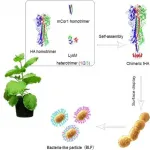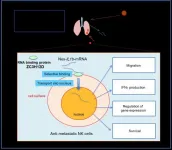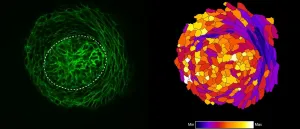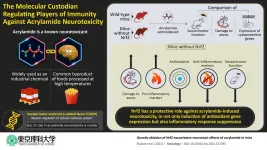Significant inequalities observed in popular Liverpool 'mass testing' pilot
2021-06-21
(Press-News.org) A study by the University of Liverpool has shown that while asymptomatic COVID-19 testing in Liverpool was popular, significant inequalities were evident between those who got tested and those who didn't.
Published in the journal The Lancet Regional Health - Europe, the study found that 43% of residents aged over 5 years (n = 214 525) took up the offer of free testing for people without symptoms of COVID-19 between 6th November 2020 and 31st January 2021. A total of 1.3% of tests were positive, meaning that 5192 individuals who did not know they had the virus were notified of the need to self-isolate, potentially breaking chains of transmission.
However, the research identified significant inequalities in who got tested. It found that uptake was lower in the most deprived areas of the city located in North Liverpool (from Everton across to Walton) with 32% of people getting tested compared to 53% of people in the least deprived areas such as Woolton and Allerton. It also found that there was lower uptake of testing amongst Black, Asian and other non-White ethnic groups, and areas classified with high digital exclusion.
In addition, these groups were also more likely to have tested positive for COVID-19. Lateral flow testing found more positive cases in the most deprived areas with 1.74% cases positive in the most deprived compared to 1.04% of tests in the least deprived areas. Among Black groups this was 1.96% and among other non-White ethnic groups it was 3.28% compared to 1.27% in White groups.
The Liverpool 'mass testing' pilot in November 2020 was the first of its kind in the World, designed to evaluate a programme providing free, drop-in voluntary testing for COVID-19 to all residents over the age of 5 years without symptoms in a large city. Findings from the pilot have gone onto inform the national roll-out of testing across the UK and strategies in other countries including the US.
Dr Mark Green, lead author of the paper, said: "The response in Liverpool towards getting tested during the 'mass testing' pilot was brilliant and we thank the people of Liverpool for helping to make it a success.
"Demand for testing was also particularly high after the pilot finished with long queues just before Christmas, as well as into the January lockdown. However, significant inequalities were evident across Liverpool in who did and didn't get tested. Those communities and populations who have been most affected by COVID-19 were also less likely to get tested. Learning how to effectively minimise inequalities in testing behaviours, including the mechanisms and barriers underpinning the relationships we identify, is critical if we are going to be able to effectively manage COVID-19 and future pandemics.
"We also found strong digital inequalities in testing patterns, with areas that were less confident in using the Internet also having lower uptake."
Professor Matt Ashton, Director of Public Health for Liverpool, said: "This paper demonstrates how important it is to consider inequalities in both the design and delivery of local and national public health interventions.
"Despite a strong comms and engagement strategy, and specific mitigation measures designed to encourage uptake in our most disadvantaged communities, there was still a significant difference in testing uptake across different communities in Liverpool. In particular it is essential to consider financial barriers to access alongside physical barriers to access, many of which may require additional financial support."
Professor Iain Buchan, Dean of the Institute of Population Health and lead for the evaluation of Liverpool community testing pilot, said "This research demonstrates why testing in a pandemic is much more than a technical exercise of implementing a test as if it were a clinical test in a hospital.
"Public health testing is a complex social and technical exercise, with important and expected inequalities to address. The lower uptake of testing and higher rates of infection among disadvantaged and BAME groups was predicted and responded to by our local public health teams who understand their communities. Locally-guided implementation of testing and nationally-backed financial support for those isolating on low incomes are important."
The authors of the paper make several recommendations including making sure test site locations were accessible and walkable, ensuring non-digital routes for testing, communicating about the benefits of testing beyond the Internet, and providing sufficient financial support to allow low-income groups to isolate so that they feel comfortable getting tested.
INFORMATION:
The paper 'Evaluating social and spatial inequalities of large scale rapid lateral flow SARS-CoV-2 antigen testing in COVID-19 management: An observational study of Liverpool, UK (November 2020 to January 2021)' (doi.org/10.1016/j.lanepe.2021.100107) is published in The Lancet Regional Health - Europe.
ELSE PRESS RELEASES FROM THIS DATE:
2021-06-21
The avian influenza, an acute viral infectious disease that occurs in poultry such as chickens, ducks, and migratory birds, has been reported to be transmittable to humans. It is difficult to control because it spreads among migratory birds that travel to China, Europe, and elsewhere. Once it is transmitted, it spreads rapidly. Disposing infected livestock is not only costly, but also a cause of serious environmental pollution. This is why vaccines against infectious diseases are imperative. To this, a research team in Korea has recently developed a plant-based, adjuvant-free, recombinant protein vaccine that exhibits a strong immune response.
Professor ...
2021-06-21
Researchers from the German Center for Infection Research (DZIF) at Charité - Universitätsmedizin Berlin and the University of Bonn have examined the way in which SARS-CoV-2 reprograms the metabolism of the host cell in order to gain an overall advantage. According to their report in Nature Communications*, the researchers were able to identify four substances which inhibit SARS-CoV-2 replication in the host cell: spermine and spermidine, substances naturally found in the body; MK-2206, an experimental cancer drug; and niclosamide, a tapeworm drug. Charité is currently conducting a trial to determine whether niclosamide is also effective against COVID-19 in humans.
Viral replication depends on host cell machinery and ...
2021-06-21
A blood test that can detect tiny amounts of circulating cancer DNA may be able to identify risk of cancer recurrence and guide precision treatment in bladder cancer following surgery, according to a clinical study led by Professor Tom Powles from Queen Mary University of London and Barts Health NHS Trust. The findings from the study, published in Nature, may change our understanding of cancer care following surgery.
The study found that patients with urothelial cancer who had a particular cancer DNA marker in their blood following surgery to remove their tumour had a higher likelihood of cancer relapse. These patients could benefit from subsequent treatment with an immunotherapy called atezolizumab.
Globally, ...
2021-06-21
In humans, adenoviruses can infect the cells of the respiratory tract, while herpes viruses can infect those of the skin and nervous system. In most cases, this does not lead to the production of new virus particles, as the viruses are suppressed by the immune system. However, adenoviruses and herpes viruses can cause persistent infections that the immune system is unable to completely suppress and that produce viral particles for years. These same viruses can also cause sudden, violent infections where affected cells release large amounts of viruses, such that the infection spreads rapidly. This can lead to serious acute diseases of the lungs or nervous system.
Automatic detection of virus-infected cells
The research group of Urs ...
2021-06-21
The authors of new research say supporting children and young people's mental health is as important as supporting their academic progress, and that particular attention should be paid to the fact that some young people have struggled more than others.
Findings from their study, published in the Journal of Affective Disorders, focused on the connections between loneliness, social contact, parental relationships, and the mental health of adolescents aged 11-16 during the first full UK lockdown from March to May 2020.
Their analysis drew on self-reported data from 894 young people who each completed a survey throughout to gauge their experiences of lockdown and its effects on their emotions, relationships, and feelings.
The team from the universities of Bath, Bristol, ...
2021-06-21
Hypoxia, or the inadequate oxygenation of a tissue, is a condition occurring frequently in all solid tumours such as melanoma skin cancer. Melanoma cells are not only able to survive oxygen deprivation, but also to use it to their own advantage by hijacking the anti-tumour immune response and developing resistance mechanisms to conventional anti-cancer therapies. A key gene responsible for cancer cell adaptation to hypoxia is HIF-1α (Hypoxia Inducible Factor-1 alpha). Led by Dr Bassam Janji, head of the Tumor Immunotherapy and Microenvironment (TIME) research group at the Luxembourg Institute ...
2021-06-21
A research group led by Professor Sachie Hiratsuka, Institute for Biomedical Research, Shinshu University, has found that a specific sequence of messenger RNA (mRNA), which exists outside cells, binds to receptors on the surface of natural killer (NK) cells and is taken up into the nucleus. The group found that NK cells with mRNA uptake are able to enhance their migration activity and interferon gamma production. Furthermore, NK cells incorporating the mRNA showed an inhibitory effect on cancer metastasis in animal experiments.
In recent years, the results of cancer treatment have been improving with the increase of medical ...
2021-06-21
Helsinki University research group used live tissue imaging for the first time to visualise the emergence of the mammary gland.
Despite long-standing interest, the cellular mechanisms driving the initiation of mammary gland development have remained elusive for decades, mostly due to technical limitations in studying dynamic cell behaviors in live tissues. Recent advances in microscopic methods and availability of various mouse models allowed the research group of Marja Mikkola from HiLIFE Institute of Biotechnology, University of Helsinki to address this question. This is the first time when live tissue imaging has been used to visualise the emergence of the mammary gland.
Mammary gland is the class-defining organ of mammals, yet we know surprisingly little how its ...
2021-06-21
Acrylamide is a toxic chemical compound that affects the nervous system. Not only is it widely used in industries such as paper production, plastics, and wastewater management, but it is also a byproduct of commonly used food processing methods, which makes human exposure to acrylamide inevitable. Therefore, many studies have focused on understanding the toxic effects of acrylamide and our body's response to them. Generally, in response to toxicity, the body's cells release protective factors and antioxidants to remedy the damage. This response is activated by various cellular machinery. One such activator is a protein called "nuclear factor erythroid 2-related factor 2" (Nrf2), ...
2021-06-21
Special diets, exercise programs, supplements and vitamins, there is everywhere something supposed to help us live longer. Whether it actually works has not always been shown, but the average life expectancy of people has increased over the last 150 years. A study by an international team of researchers, including Claudia Fichtel and Peter Kappeler, scientists in the Behavioral Ecology and Sociobiology Unit at the German Primate Center (DPZ) - Leibniz Institute for Primate Research in Göttingen, indicates that we probably cannot slow down aging. The comparative studies with humans and non-human primates, indicates that it is not the rate at which humans age that slows ...
LAST 30 PRESS RELEASES:
[Press-News.org] Significant inequalities observed in popular Liverpool 'mass testing' pilot






